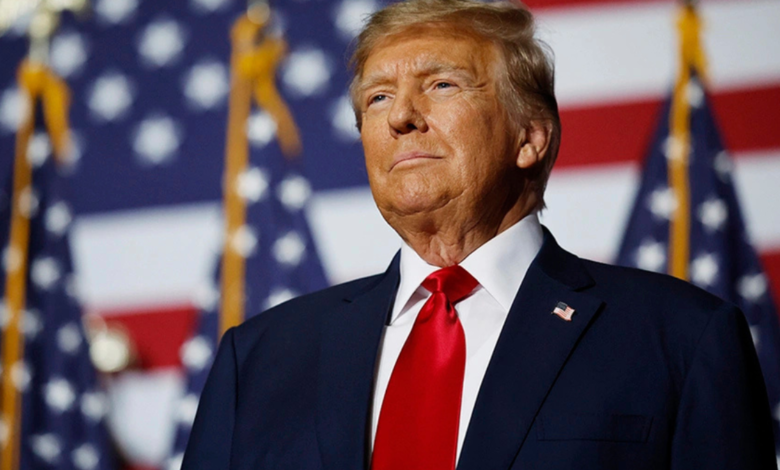CNN and Donald Trump: A Complex Relationship

The relationship between CNN and Donald Trump has been one of the most talked-about dynamics in the media landscape over the past decade. Their interactions have been defined by controversy, clashes, and mutual distrust, yet also an undeniable symbiotic relationship that benefits both sides in terms of ratings, influence, and public perception. From fiery exchanges during Trump’s presidency to the ongoing media wars post-presidency, CNN’s coverage of Donald Trump has played a pivotal role in shaping the political and media environment.
1. The Beginnings of CNN and Trump’s Media Relationship
This article delves into the intricacies of the CNN-Trump relationship, looking at how CNN has covered Trump over the years,Donald Trump the impact of this coverage on public opinion, and the broader implications for the media and democracy.
The Early Years: CNN as a News Powerhouse
CNN, launched in 1980 by media mogul Ted Turner, quickly became a major force in 24-hour news broadcasting. It revolutionized the way news was consumed, offering round-the-clock coverage of breaking stories and in-depth reporting. The network built its reputation on covering a wide range of issues, from global events to domestic politics.
Donald Trump, on the other hand, entered the public eye in the 1980s, initially as a real estate mogul and later as a reality TV star on “The Apprentice.” His media presence was always larger-than-life, and his persona was that of a wealthy, controversial businessman with a knack for making headlines. However, their relationship was mostly cordial in the early years, with Trump frequently appearing on CNN for interviews and discussions. This was in line with his strategy of maintaining a high media profile, as CNN was one of the leading news networks at the time.
The Shift to Politics: Trump’s 2016 Presidential Campaign
The dynamics between CNN and Trump began to shift dramatically in 2015 when Trump announced his candidacy for the 2016 presidential election.Donald Trump At the time, CNN was one of the primary outlets covering Trump’s campaign, often broadcasting his rallies and speeches live. Trump, known for his polarizing and unorthodox style, provided CNN with plenty of content, including controversial statements and provocative rhetoric.
2. CNN’s Coverage of Donald Trump During the 2016 Election
Initially, CNN, along with other networks, seemed to treat Trump as a curiosity—an outsider with little chance of winning. However, as his campaign gained momentum and the Republican field narrowed, Trump’s media strategy became clearer. He realized that controversy and confrontation were key to staying in the public eye, and CNN was more than willing to give him the platform to do so. The phrase “media circus” quickly became synonymous with Trump’s candidacy,Donald Trump and CNN, with its 24/7 news cycle, was at the center of it all.
Breaking News and Controversial Statements
The 2016 presidential campaign marked a defining moment in the relationship between CNN and Donald Trump. Trump’s candidacy was marked by a series of controversial statements that grabbed headlines—whether he was calling Mexican immigrants “rapists” or claiming that the election was “rigged.” CNN, like many other media outlets, was quick to report on these incidents, often providing live coverage of his rallies and interviews.
While some of Trump’s statements were outright inflammatory, CNN’s decision to air them in full, sometimes without much context, led to criticism from both sides of the political spectrum. On one hand, critics of Trump argued that CNN was giving him too much airtime, effectively legitimizing his more extreme views. On the other hand, Trump’s supporters saw CNN’s constant coverage as a form of media bias, accusing the network of unfairly targeting the candidate.
The Role of the Debates: CNN’s Spotlight on Trump’s Rhetoric
The 2016 Republican debates were another major chapter in the CNN-Trump saga. Trump’s bombastic rhetoric stood out in the crowded field of Republican candidates, and CNN, which hosted some of the debates, provided a platform for Trump to directly challenge his rivals. His debate performances became a media spectacle, drawing millions of viewers who tuned in to watch his sharp exchanges with other candidates.
3. The CNN-Trump Feud During the 2016 Election and Beyond
Trump’s ability to dominate the media landscape during the debates was a testament to his understanding of how to manipulate the news cycle. He often used the debates as an opportunity to attack the media, with CNN frequently being in his crosshairs. This only fueled the relationship between CNN and Trump—one marked by mutual antagonism, but also one that relied heavily on each other for relevance.
Trump’s Attacks on CNN: “Fake News” and the Media Wars
By the time of the general election in 2016, the relationship between CNN and Trump had reached a boiling point. Trump had become increasingly vocal about his disdain for the media, particularly CNN, which he repeatedly accused of spreading “fake news.” These attacks were part of a broader strategy to undermine the media’s credibility, especially as his campaign faced mounting criticism for his divisive rhetoric and policies.
Trump’s rhetoric against CNN was consistent throughout his presidency. He regularly referred to the network as “fake news” and attacked individual reporters, most notably CNN’s Jim Acosta. These public clashes became a central feature of his presidency, as Trump often used his platform to rally his supporters against the mainstream media. CNN, in turn, stood by its reporting, framing Trump’s attacks as part of a broader effort to stifle dissent and undermine democratic institutions.
The CNN vs. Trump Brand of Politics
One of the most striking features of the CNN-Trump relationship was the way it transcended traditional political discourse. CNN became a symbol of the “resistance” to Trump’s policies, while Trump positioned himself as a populist hero fighting against the so-called “liberal media elite.” This created a dynamic in which the public became increasingly polarized, with each side viewing the conflict as a battle between truth and falsehood, fairness and bias.
4. The Post-Presidency Era: CNN’s Continued Focus on Trump
The rivalry between CNN and Trump also had tangible consequences for journalism. Trump’s attacks on CNN were part of a broader campaign to delegitimize the media as a whole, with some of his supporters echoing his claims that news outlets were biased against him. This made it more difficult for journalists to maintain their credibility, as they were often caught between accusations of partisanship and the pressure to provide balanced coverage of a president who was anything but typical.
Trump’s Post-Presidential Media Dominance
After losing the 2020 presidential election, Trump’s media presence did not wane. In fact, his post-presidency era has been marked by a continued media frenzy surrounding his activities. CNN, along with other major outlets, has continued to focus on Trump’s post-presidential statements, rallies, and political maneuverings. Whether it’s his efforts to remain politically relevant or his claims of election fraud, Trump’s name continues to dominate the headlines.
CNN’s decision to keep Trump in the spotlight has not been without controversy. Critics argue that the network is giving too much attention to a figure who no longer holds political office, while others believe that covering Trump’s every move is essential for holding him accountable. Regardless of the criticism, CNN remains committed to reporting on Trump, especially as he continues to hint at a possible 2024 run for the presidency.
The Trump CNN Legacy: What’s Next?
Looking ahead, it’s clear that the CNN-Trump relationship will remain a central feature of the media landscape. Trump’s influence on American politics shows no signs of waning, and CNN will likely continue to cover him extensively. However, the question remains: will CNN’s focus on Trump continue to drive ratings and public interest, or will the American public’s attention eventually shift away from the former president?
5. The Impact of CNN’s Coverage of Trump on Public Perception
As CNN faces increased competition from other news outlets, including more conservative-leaning networks like Fox News and Newsmax, the network will have to navigate the challenge of covering Trump in a way that balances journalistic integrity with audience demand. At the same time, Trump will continue to wield his media power, whether through rallies, interviews, or social media, ensuring that his relationship with CNN remains as complicated and contentious as ever.
Polarization and the Role of Media
One of the most significant outcomes of CNN’s coverage of Donald Trump is the increasing polarization of the American public. Trump’s ability to dominate the media and generate controversy has created a situation where news outlets like CNN are often viewed through a partisan lens. For many of Trump’s supporters, CNN is seen as the enemy—a biased network that has waged an unrelenting campaign against the former president. For his detractors, CNN is often seen as a beacon of truth in the battle against a man they view as a threat to democracy.
This polarization has contributed to a broader crisis of trust in the media. As CNN and other news outlets continue to report on Trump’s actions, it becomes more difficult for people to agree on what constitutes factual reporting. The result is a media ecosystem where different audiences consume information from sources that align with their preexisting beliefs, further entrenching the divisions in American society.
The Role of Social Media in Amplifying CNN’s Coverage
Social media has played an integral role in amplifying CNN’s coverage of Trump. The rise of platforms like Twitter, Facebook, and YouTube has allowed Trump’s supporters and detractors to engage directly with CNN’s reporting, often reinforcing or challenging the network’s narratives. Trump himself has been a prolific user of social media, using platforms like Twitter (before his ban) to directly attack CNN and its journalists.
This interaction between traditional media and social media has created a feedback loop, where CNN’s coverage of Trump is both shaped by and shapes the discourse on social platforms. Whether through memes, viral clips, or direct commentary from Trump’s followers, the media landscape surrounding Trump is a complex web of influence that extends beyond traditional journalism.
6. Conclusion: The Enduring CNN-Trump Saga
The relationship between CNN and Donald Trump has been one of the most defining features of the modern media landscape. From Trump’s rise to political prominence to his post-presidential media dominance, CNN has been at the center of the storm, covering his every move, statement, and controversy. This ongoing relationship has raised important questions about the role of media in a polarized society, the responsibility of news outlets to provide balanced coverage, and the ways in which media figures like Trump can manipulate public opinion.
As we look ahead, it’s clear that CNN will continue to play a key role in covering Trump’s political future. Whether or not Trump runs for president again in 2024, his media presence will remain a significant force in American politics. For CNN, navigating this complex relationship will require a careful balance of journalistic integrity and audience demand, while also adapting to the ever-changing landscape of digital media and public opinion.





